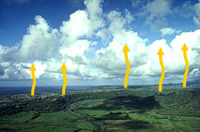Planetary Energy Balance
Heat Transfer
Heat can be transferred from one object or parcel of fluid (liquid or gas) and moved to another location in a few different ways.
| CONDUCTION | CONVECTION | RADIATION |
 |
 |
 |
| Conduction is the transfer of molecular kinetic energy within a material or by direct contact of two (usually solid) objects. The heat moves (diffuses) along a thermal gradient from warmer to cooler temperatures until the temperature equilibrates. The molecules of one object collide with neighboring molecules and thus transfer kinetic energy, or heat. | Convection is the transfer of heat by the large-scale movement of a parcel of fluid (liquid or gas) from one place to another in a gravitational field, due to the fact that warmer fluids are less dense than cooler fluids. (“Hot air rises.”) This moves heat by moving the material that carries it. | Radiation is the transfer of energy by electromagnetic radiation of various wavelengths, including visible light, radio, x-rays, etc. Electromagnetic radiation is emitted by all objects, and the frequency (thus energy) depends on the temperature of the emitting object. The radiation is absorbed by another object thus raising its temperature. |
| DID YOU KNOW? | |
| The terms advection can sometimes be confused with convection. | Advection is the transfer of heat by (typically) horizontal motion of fluid not directly involved in convective rise due to density differences. |

